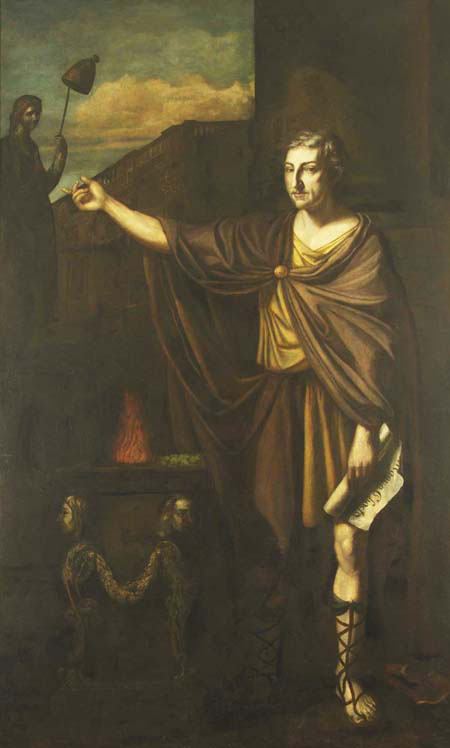
Known as the "Great Commoner," Whig statesman William Pitt was born near London in 1708. He was elected to the House of Commons and served as Secretary of State. In 1766 Pitt was named Earl of Chatham, at which time he assumed a place in the House of Lords. Pitt was an active proponent of colonial rights. American colonists admired him for his opposition to the Stamp Act of 1765, in which Parliament taxed nearly every paper document passing through colonists' hands, including newspapers, licenses, and even playing cards. Pitt believed that Parliament should pursue increased trade, not taxation, with colonists to generate revenue.
Englishman Edmund Jenings arranged for Maryland artist Charles Willson Peale to paint a portrait of Pitt while Peale was studying in England. Jenings had been asked by a group of wealthy Virginia businessmen from Westmoreland County to procure a portrait of a British leader sympathetic to colonial American rights for display in the lower house of the Virginia legislature. When the first choice, a portrait of Charles Pratt, Baron Camden, by American expatriate Benjamin West, did not materialize, Jenings turned to the relatively inexperienced Peale for a portrait of Pitt. Seeing an opportunity to make his artistic mark, Peale accepted the commission, painting two full-length versions of the Pitt portrait. He based his likeness on a bust of Pitt by British sculptor Joseph Wilton (1722-1803).
Peale's portrait of Pitt shows him in a setting filled with objects that carried particular meanings, or symbols. The portrait has been called an allegory, for many of the details in it can be interpreted as republican symbols. For instance, Pitt appears not in the robes of an earl, but in classical dress. This associated the statesman with classical Roman heroes who would have worn similar attire (it also avoided connecting Pitt with English aristocracy, which might not have been received well by American viewers). In a 1768 broadside, Peale described other republican symbols in the painting, such as the copy of Magna Carta Pitt holds in his left hand. The original English document, written in 1215 in Runnymede, allowed that the basic rights of English barons (and later, freemen) be recorded and confirmed with King John's royal seal. American colonists looked to this document as a model for their own Declaration of Independence. Pitt points with his right hand to a statue of British liberty. The female figure holds a staff topped with the liberty cap of the ancient Romans. Ironically, she tramples the petition against the Stamp Act drafted at the 1765 Congress at New York. For Peale, Liberty's represented action signified that "States which enjoy the highest Degree of Liberty are apt to be oppressive of those who are subordinate." Other symbols in the portrait include the American Indian, who, with a dog at his side, shows the faithfulness and firmness of America; an altar with a perpetual flame, illustrating the sacred cause of liberty, on which are carved busts of the famous Whigs Hampden and Sidney; and, in the background of the portrait, the Banqueting House of Whitehall, from which British monarch Charles I was led to his execution in 1649 after years of dispute with Parliament resulted in English civil war. Peale, a fervent supporter of republican values, drew many of these visual details from established symbolism created by Whig artists. They would have been recognizable to both English and American audiences.
The Peale portrait of Pitt that hangs in the Maryland State House was the first of the two versions Peale painted. The second, per the conditions of the original commission, was sent to Westmoreland County. It now hangs in the Westmoreland County Museum in Montross, VA. Peale offered the first version to the Maryland legislature in a resolution introduced by John Ridout in 1774:
"Charles Wilson [sic] Peale of the City of Annapolis Limner, impressed with a strong sense of Duty to his native Province projected when in London and since hath compleated the portrait of the Earl of Chatham on Canvass at full length, with a view humbly to offer the same to his Country, as a tribute of Gratitude, And presumes to entreat a favourable acceptance of that portrait, to be placed in the State House or such other conspicuous place as shall be thought most fit and Convenient. Thus eminently to dispose of the first Fruit of his Science will much redound to his Reputation and confer an Honour which he shall forever acknowledge with Gratitude and Thanks." (Upper House Journal 37, pp. 6-7)
The Assembly accepted Peale's offer and presented him a "compliment" of one hundred pounds. Peale also produced a mezzotint, or print, after the Westmoreland portrait, a copy of which is held by the Pennsylvania Academy of Fine Arts.